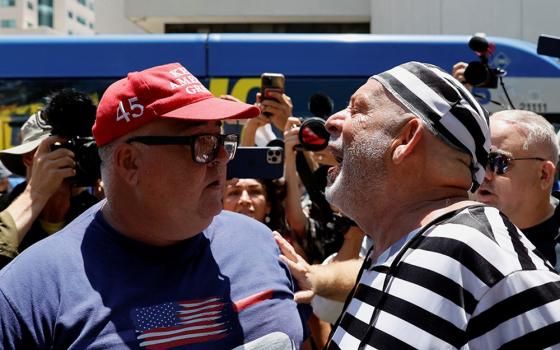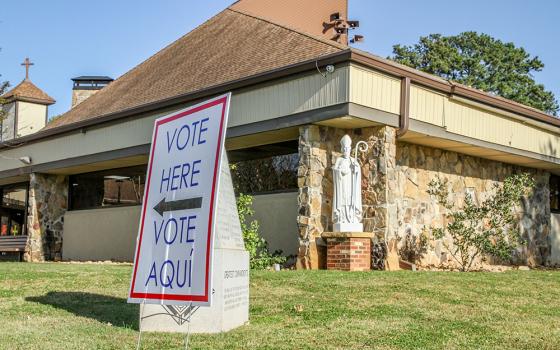A former Salvadoran defense minister faces deportation after a U.S. judge in Miami found that atrocities committed by troops under his command were not fully investigated, much less prosecuted. Those atrocities include the killings of Salvadoran Archbishop Oscar Romero, four U.S. churchwomen, and more than 1,000 peasants at El Mozote, the worst massacre of civilians in contemporary Latin American history.
In a lengthy 66-page ruling that covers several years of the country's bloody history, Immigration Judge Michael C. Horn found Feb. 26 that former Gen. Jose Guillermo Garcia protected death squads and "assisted or otherwise participated in" torture and assassinations during his tenure as defense minister from October 1979 to April 1983.
The decision was released April 11 as the result of a New York Times Freedom of Information Act request.
The judge concluded that as the head of the armed forces and the most powerful person in the country, Garcia took no measures to stop the atrocities that he "knew or should have known" were being committed, given that "dead bodies bearing signs of torture were heaped in piles on the streets of the capital city, along well-traveled highways, in shopping centers, and in parking lots of prestigious hotels. Tortured corpses, some beheaded, some dismembered, were left to decay in the Playon Body Dump, accessible only with the consent of the military."
Garcia, 80, is appealing the decision. He has been living in Miami since 1989 after he claimed he feared for his life and was granted asylum.
The ruling is a detailed and scathing indictment of Garcia, but it doesn't convey the extent of the massive involvement of the United States in the training, arming and advising of Garcia's military.
While the ruling does describe Garcia's military training, it fails to mention that he graduated from the counterinsurgency program at the U.S. Army's School of the Americas (SOA), then based in Panama. The school was moved in 1984 to Fort Benning, Ga., and in 2000, the Pentagon renamed it the Western Hemisphere Institute for Security Cooperation.
A recipient of the U.S. Legion of Merit Award, Garcia once argued that he was only carrying out an anti-communist campaign with Washington's blessing.
The judge concluded, however, that Garcia allowed the Salvadoran military "to prey upon defenseless civilians under the guise of fighting a war against communist subversives" by creating "an atmosphere of impunity in which members of the armed forces would not be investigated, prosecuted, sanctioned, or discharged for atrocities visited upon civilians."
The magnitude of the killings and the torture by the military, coupled with Garcia's failure to try to stop or seriously investigate them, led the court to conclude that the atrocities formed part of Garcia's "deliberate military policy."
The court ruled that Garcia "assisted or otherwise participated in" 14 assassinations, six specific massacres, and the torture of three specific individuals in addition to the torture and killings of countless civilians by forces under his command.
The court found that during Garcia's tenure as minister of defense, the military was behind 59 massacres, at least 1,800 killings of civilians, 920 disappearances and the torture of 580 people.
Homeland Security Department lawyers initiated the proceedings against Garcia in 2009 under a 2004 law aimed at denying asylum to terrorists. The evidence was based in part on the landmark 1993 U.N. Truth Commission report, U.S. State Department documents and diplomatic cables, and testimony by Robert White, the former U.S. ambassador to El Salvador.
The court notes that Garcia plotted with others to overthrow Gen. Carlos Humberto Romero, another SOA graduate, in October 1979, a coup carried out by a group of young reformist military officers.
But what is not suggested is the view of Cornell University historian Walter LaFeber in Inevitable Revolutions: The Jimmy Carter administration had encouraged the coup in the months after Anastasio Somoza Debayle was toppled in neighboring Nicaragua in July 1979.
The court does note that while Garcia was not a reformist, he gained reformists' backing to become defense minister in part by highlighting his connections to United States officials, but the court never spells out what those connections were.
As defense minister, the court said, Garcia gained "operational control of the armed forces and became, in effect, the power behind the throne."
He not only refused to pursue an investigation of Romero's assassination, but two months later, the court noted, Garcia freed 11 hardliners who had been arrested by troops loyal to a reformist military officer on the junta as they plotted "an elaborate death squad operation aimed at bringing about 'total war.' " One of the seized documents was a notebook containing the payments and plans to assassinate Romero.
Among the conspirators Garcia released were Maj. Domingo Monterrosa, who a year later would command the troops that slaughtered the village of El Mozote, and Maj. Roberto D'Aubuisson, the organizer of the death squad that killed the archbishop and whom Garcia secretly kept on the payroll even though he had been cashiered from the military for his involvement in the 1979 coup.
Garcia's actions, the court found, resulted in "advancing the violent activities of this group of officers and Major D'Aubuisson by sending the message that they would be protected from investigation and prosecution."
"What followed was a period of mass state terror in which torture, murder, and disappearance threatened the entire population," the court concluded. The 11 officers "went on to commit vile acts, including: organization and participation in death squads; torture; the Sheraton Hotel murders; the assassinations of the four American churchwomen; the FDR murders; the El Mozote massacre; and the Las Hojas and Agua Santa massacre and cover-up."
Not mentioned in the ruling was the fact that nine of the 11 freed conspirators were SOA graduates, as were 10 of the 12 officers cited by the Truth Commission for the massacre at El Mozote; the only officer cited for the Rio Sumpul massacre; three of the five officers cited for the murders of the churchwomen; two of the three cited for Romero's killing; and the three officers cited for the Sheraton Hotel murders.
Nor is there any mention that Garcia was getting U.S. military advisers and mixed messages from Washington. Romero had sent President Jimmy Carter a letter asking him to cut off U.S. aid, but the Carter administration rebuffed him and right after his assassination pushed through a $5.7 million military aid package to El Salvador, conveying the clear message to Garcia that not even an archbishop's death would reduce U.S. support.
Similarly, Carter kept the aid flowing after the four churchwomen were killed, shutting it off only for a brief two-week period.
The court did note that White, the former U.S. ambassador to El Salvador, was dismissed by the Ronald Reagan administration after he refused to send a telegram to the State Department "asserting that the Salvadoran military was making a good-faith effort to find and punish the people who killed the four American churchwomen." But it does not mention that Secretary of State Alexander Haig Jr. helped Garcia downplay the churchwomen's murders by suggesting they were armed and ran a road block.
Nor did it mention that, like Garcia, the Reagan administration dismissed reports of the massacre at El Mozote as "not credible" and went on to certify that the Salvadoran junta was making a "concerted and significant effort" to comply with international human rights standards. At the same time, the Reagan administration encouraged the Salvadoran military to adopt Low Intensity Warfare tactics that advocated using almost any means necessary to achieve political ends.
Carlos Vides Casanova -- another Salvadoran defense minister and recipient of the Legion of Merit award who faces deportation for overseeing massive human rights violations, including torture and assassinations -- has argued that his actions were supported and funded by U.S. government officials.
White has said that Vides Casanova's actions are indefensible, but "it would be useful for us to examine our own record because it keeps coming back to haunt us."
Charges against Gen. Jose Guillermo Garcia:
Former Salvadoran defense minister Gen. Jose Guillermo Garcia faces deportation after a Miami court ruling found Garcia protected death squads and "assisted or otherwise participated in" 14 assassinations, six specific massacres, and the torture of three specific individuals in addition to the torture and killings of countless civilians by forces under his command, including:
- The March 24, 1980, assassination of Archbishop Oscar Romero, which Garcia failed to investigate, releasing officers who had been arrested with incriminating documents;
- The May 14, 1980, Rio Sumpul massacre of approximately 600 civilians in which children and babies were thrown into the air and slashed to death with machetes, which Garcia denied and never investigated;
- The May 29, 1980, San Francisco Guajoyo Massacre in which 10 members of a cooperative and two agrarian reform workers were shot at close range; Garcia made no effort to identify and punish those responsible;
- The Nov. 27, 1980, assassinations of six leaders of the Frente Democratico Revolucionario (FDR), an umbrella group for the unarmed civilian opposition, who were abducted from a Jesuit school and mutilated by security forces. The court cites a U.S. government cable stating, "Most military officers were highly pleased with the assassination ... [and] believe that other leaders and members of the FDR should be eliminated in a similar fashion ... [and that Garcia] supported this line of thinking."
- The Dec. 2, 1980, murders of four U.S. churchwomen, who had been raped and shot at close range. The court concluded that Garcia made no serious effort to conduct an investigation;
- The Jan. 3, 1981, assassinations of three labor union leaders at the Sheraton Hotel, including two Americans. Garcia, under pressure from the United States, ordered two investigations that resulted in no action, even though the gunmen stated they were following orders of National Guard commanders.
- The April 7, 1981, Soyapango Massacre in which at least 24 civilians were killed by Treasury Police, who were under the command of Francisco Moran, a Garcia appointee. Under mounting U.S. pressure, the Salvadoran government acknowledged the role of the security forces, but Garcia refused to remove Moran.
- The Dec. 10, 1981, El Mozote massacre in which the Atlacatl Battalion systematically executed 1,000 villagers, including more than 250 children under the age of 12. Garcia denied the massacre, telling the U.S. ambassador it was a fairy tale and a pack of Marxist lies, and he refused to order an investigation.
- The Aug. 22, 1982, El Calabozo massacre in which the Atlacatl Battalion machine-gunned more than 200 men, women and children and threw acid on some of the bodies to dissolve them, making an exact death toll impossible to confirm. The court found that Garcia did not investigate this massacre, denying it ever occurred.
- The Feb. 23, 1983, Las Hojas and Agana Santa Massacre in which 16 civilians from a cooperative were shot at close range, their arms tied behind their backs. Under pressure from the United States, Garcia appointed a colonel to conduct an inquiry that the court found to be a cover-up.
In sum, the court found that during Garcia's tenure as minister of defense from October 1979 to April 1983, the military was behind 59 massacres, at least 1,800 killings of civilians, 920 disappearances, and the torture of 580 people.
[Linda Cooper and James Hodge are the authors of Disturbing the Peace: The Story of Father Roy Bourgeois and the Movement to Close the School of Americas.]



